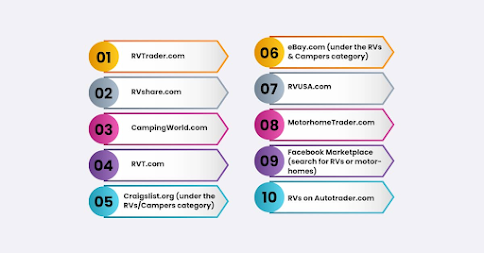Scrape RV Data for RV Pricing Data Insights?
In today’s fast-moving market, it’s super important to know the prices of things, especially when you’re thinking about buying something big like an RV. We all want to get the best value for our money, right? That’s where having access to real-time pricing info comes in handy. And guess what? Thanks to technology, there’s a cool thing called web scraping that helps us gather pricing details from lots of different websites.
Analyzing consumer behavior and market characteristics, such as drivers, constraints, and opportunities, may give significant insights into the Recreational Vehicle (RV) industry.
Key Statistics
- The recreational vehicle market is projected to increase at a compound annual growth rate (CAGR) of 8.15% from 2024 to 2029, from an estimated USD 33.23 billion in 2024 to USD 49.18 billion by that time.
- Between 2017 and 2022, the Recreational Vehicle (RV) market experienced substantial growth, soaring from USD million to USD billion.
- Projections indicate a continued upward trajectory, with the market expected to hit USD million by 2029, driven by a promising compound annual growth rate (CAGR).
- The size of the RV rental market was estimated at USD 952.33 million in 2023 and is expected to increase at a compound annual growth rate (CAGR) of 10.09% to reach USD 1,866.48 million by 2030.
Let’s evaluate the top ten states of the US where people usually spend the most RV sales and services per year:
California: $549,800,000
Texas: $424,200,000
Florida: $306,200,000
New York: $225,900,000
Minnesota: $187,400,000
Arizona: $174,400,000
Illinois: $173,800,000
Pennsylvania: $170,600,000
Oregon: $165,600,000
Washington: $155,700,000
What is Recreational Vehicle Data Scraping?
Recreational vehicle (RV) data scraping refers to the process of automatically gathering pricing information for RVs from various sources on the internet. This involves using software or scripts to extract price data from websites where RVs are listed for sale, such as dealer websites, classified ad platforms, or specialized RV marketplaces. After performing RV data scraping, the extracted data can then be used for analysis, comparison, or to inform purchasing decisions.
It’s crucial to remember that ethical and legal alternatives exist for gathering RV price information. These include:
- Utilizing established RV listing platforms like RVTrader or Camping World.
- Visiting manufacturer and dealership websites that display pricing information.
- Consulting industry reports and publications for market trends and average pricing.
- Attending RV shows and events for firsthand experience and price comparisons.
- Engaging with online RV communities and forums for insights and recommendations.
- Utilizing price comparison tools that aggregate RV listings from various sources.
Steps of the Recreational Vehicle (RV) Price Scraping Process:
By following these steps, you can scrape RV data and prices from different websites and use the data to make smart buying decisions, track market trends, or see how you stack up against the competition. Just remember to be respectful and follow the rules of the websites you’re scraping from.
1. Identifying Sources:
Businesses can start by making a list of websites where RVs are listed for sale, like dealerships, online marketplaces, or classified ad platforms. Search for sites with detailed info about RVs, including their make, model, year, condition, mileage, and price. Experts can check if the websites you choose are trustworthy and reliable to ensure the price info you collect is accurate.
2. Accessing Website Data:
Use programming tools like Python’s requests module to visit the URLs of the websites you’ve picked. By making requests to these URLs, businesses can quickly get the HTML content of the pages where RV data and prices are shown. If needed, handle any login or authentication steps to access restricted content on the websites.
3. Parsing HTML Content:
Once you have the HTML content, use tools like BeautifulSoup or lxml in Python to pick out the info you want from the page. It becomes easy to find the HTML elements that hold the price info, like <div> or <span> tags with specific class or ID names. Also, grab other essential details about the RV listings, such as their make, model, year, and description, to give context to the price data.
4. Handling Dynamic Content:
Some sites show RV data and prices using fancy techniques like AJAX or JavaScript, which means the prices might not be there when the page first loads. In these cases, you might need to use special tools like Selenium WebDriver to interact with the page like a real person would, triggering the loading of the price data. Once the dynamic content is loaded, you can grab the price info using the same techniques as for static content.
5. Storing the Data:
Save the price data you’ve scraped in a structured format, like a CSV file, JSON document, or database table. Include extra info with each price entry, like the URL of the website where you found it, the date and time you scraped it, and any tags or categories that might be helpful.
6. Regular Updates:
Set up a system to scrape the price data regularly from the websites you’re interested in, so you always have the latest data. Keep an eye on the websites to see if they change their structure or try to stop you from scraping, and adjust your scraping code accordingly.
Importance of Web Scraping RV Data:
RV data scraping is really important for businesses in the RV industry or those wanting to buy or sell RVs. Here’s why:
1. Market Research:
Scraping helps businesses collect lots of data about RVs, like how much they’re selling for, what’s available, and which models are popular. This helps them understand what customers want and make smart decisions about what to sell and how much to charge.
2. Competitive Analysis:
By scraping data from other sellers’ websites, businesses can learn about their competitors’ prices, deals, and products. This helps them see how they compare against other sellers and devise ways to stay ahead.
3. Price Monitoring:
Scraping lets people monitor RV prices across different websites in real time. This helps sellers adjust their prices based on market conditions, such as rising or falling demand.
4. Inventory Tracking:
RV dealers and rental companies can use scraping to keep track of how many RVs they have available and where they are. This helps them manage their inventory better and make sure they have what customers want.
5. Lead Generation:
Scraping can help businesses find potential customers who are interested in buying or renting an RV. By collecting contact info from ads or websites, businesses can reach out to these people and offer them what they want.
6. Customer Insights:
Analyzing scraped data can show businesses what features and prices customers prefer in an RV. This helps them tailor their marketing and improve their products to meet customers’ needs better.
7. Marketplace Integration:
Scraping is crucial for websites that gather RV listings from different sources. It helps them collect all the info in one place so customers can easily compare prices and features.
List of Websites for Smooth RV Data Scraping:
Here is a list of standard websites and platforms where RV prices can typically be found:
- RVTrader.com
- RVshare.com
- CampingWorld.com
- RVT.com
- Craigslist.org (under the RVs/Campers category)
- eBay.com (under the RVs & Campers category)
- RVUSA.com
- MotorhomeTrader.com
- Facebook Marketplace (search for RVs or motorhomes)
- RVs on Autotrader.com
These websites often feature listings from dealerships, private sellers, and rental companies, providing a wide range of RVs with varying prices and specifications by performing Web Scraping RV Data.
Challenges of Web Scraping RV Data
Scraping RV prices has its own difficulties because of how the data is and the websites that host it. Here’s a simpler explanation of the challenges:
1. Dynamic Pricing:
RV prices change a lot because of things like how much people want them, the time of year, and how sellers decide to price them. This makes it tough to get the exact prices at any given moment.
2. Complex HTML Structures:
Websites that list RVs can have complicated layouts with lots of nested parts and things that change when you look at them. Getting the price info out of these structures correctly needs careful handling and smart techniques.
3. Anti-Scraping Measures:
Some websites don’t want bots or automated tools to take their data, so they put up obstacles like CAPTCHA tests or blocking certain IP addresses. This makes it harder to scrape prices without getting noticed.
4. Authentication and Access Restrictions:
Some websites need you to log in or have special rules for who can see their prices. Scraping data from these sites means dealing with these extra steps, which adds more work to the scraping process.
5. Data Quality and Accuracy:
The price data you scrape might not always be perfect. It can depend on how reliable the source is, how much info they have, and if there are any mistakes or missing details in the scraped data.
6. Legal and Ethical Considerations:
Scraping prices from websites might not always be allowed by the site’s rules or the law. It’s essential to make sure you’re following the rules and being ethical when scraping data from websites.
Conclusion
Web scraping RV data uses a special tool to gather information from online sources. Web scraping can lead to a data-driven decision-making process for people looking to buy an RV (recreational vehicle). It helps them find out how much RVs cost right now by collecting prices from different websites. To do this effectively, you need to pick the right tools and make sure you’re getting your information and detailed RV data from reliable websites. Once you’ve got everything set up, you can create a kind of recipe called a scraping script that tells the tool exactly what information you want to collect. Despite the challenges, X-Byte helps you to plan carefully, use good scraping techniques, and follow the rules, you can still effectively perform RV data scraping to make decisions or perform analysis.
This Blog is originally published here.






Comments
Post a Comment